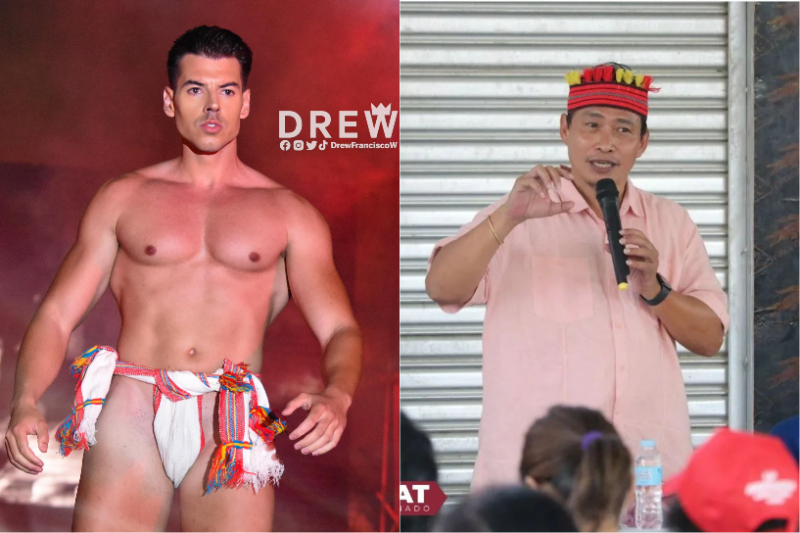(Updated; June 18, 3:46 p.m.) Former Ifugao representative Teddy Baguilat reminded that “due diligence” should be considered in wearing traditional attire like the “bahag” or the loincloth worn by indigenous people after it was refashioned as swimwear in a male beauty pageant.
The former senatorial candidate on Monday tweeted the reminder after learning that some candidates in the Man of the World 2022 pageant wore the traditional Filipino garment in the competition in a different manner.
The “bahag” is a loincloth commonly used in the country before the arrival of the Spanish colonizers. It was usually worn by commoners and the serf class.
The garment is still being worn by indigenous tribes in the Cordillera in Northern Luzon, the Igorots.
A portion of the cloth hangs in front and at the back in a rectangular way to cover the groin area.
In the male beauty contest, however, some bets were seen wearing it differently to resemble modern underwear.
“Seriously, due diligence lang. Especially in portraying IKSP and IP culture by non-IPs,” Baguilat tweeted on June 13.
IKSP refers to Indigenous Knowledge Systems and Practices, while IP refers to Indigenous Peoples.
“Mali ang paggamit nila ng bahag. Ginawang sex toy,” the former lawmaker said in another tweet.
“Talo kayo sa akin (but this was 19 years ago (and) 30 pounds lighter hehe). Pero talo sana kayo. Kung kinareer ko lang, #MisrepresentationOfIPCulture,” Baguilat wrote, adding a picture of him wearing the traditional garment.
During the campaign period, Baguilat wore a “bahag” in sorties to highlight his platform of championing indigenous people’s rights.
Baguilat was not the only one disappointed.
The National Commission on Indigenous Peoples-Cordillera Administrative Region (NCIP-CAR) said that they “did not allow nor tolerate the way the ‘bahag’ was worn during the said competition.”
It admitted, however, that it received a letter from the pageant’s chairman about the garment being featured during its swimwear portion and the finals.
“That they have an expert with them during the competition to ensure that these are worn the right way. In response this office did not interpose any objection on it for as long as the same is worn properly by the contestants,” NCIP-CAR said in a statement.
It also asked organizers of the pageant to give them “concrete” and “anthropological proof” supporting claims that Filipino ancestors wore it in such a way during underwater activities.
“In this wise, we can help provide more accurate data, and information which will help us understand the evolution of our culture. We call upon these proofs, as many of us have grown in a society where we did not witness our ancestors tie their G-string the way it was during the competition,” NCIP-CAR added.
“We have grown in a society where our traditional attires are worn by us on special occasions, festivals, and the like. We have grown with our elders teaching us the proper way to wear these attires, and thus what we know today,” it further said.
“The ‘bahag (G-string) just like any other traditional garments should be accorded the highest respect by wearing them properly and for the purpose they were made,” the office continued.
TAKDER (Cordillera Youth Movement for Democracy and Prosperity) also said that it is hoping for the pageant organizers’ apology to “correct this cultural appropriation.”
“Our mountains have safeguarded our culture for hundreds of years. The Cordilleran people will be more than willing to share these as long as it is done properly and respectfully,” the group said in a statement.
“We should then integrate and learn their ways firsthand. This way, we can understand that cultures older than us should not be used to sexualize or objectify people,” TAKDER added.
“When we wear our cultural attires, we wear our identity, our history, and our people—we hope that we can use events such as pageantry to make them understand that the practice of our tradition and culture is not a spectacle that should be reduced for others’ entertainment. We are not commodities but human beings,” the group continued.
For lawyer Mary Ann Manja Bayang, however, she “did not see any exploitation” in the event.
“The significance of the bahag was thoroughly explained to them (the candidates), they were able to explain it also to themselves, it means they understood it, then I agreed to take part in the event,” she said in a media conference.
“And I think that this is a good platform to promote the culture, to promote the traditional attires of the Cordillera. I did not see any exploitation, I did not see any commercialization. I saw it as a good platform for promotion,” Bayang added.

